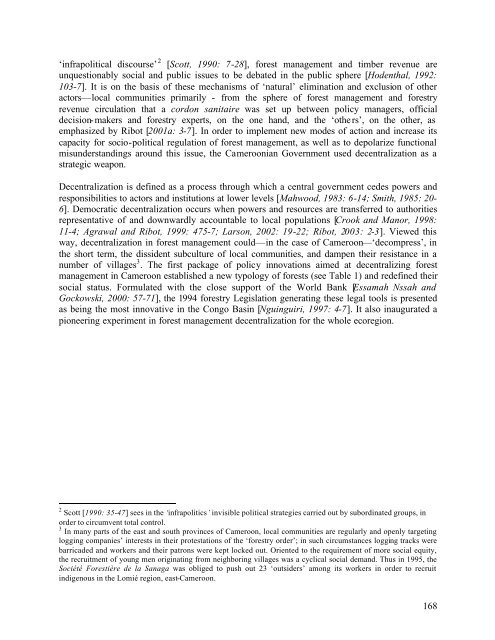chapter 10 social and organizational roots of ecological ...
chapter 10 social and organizational roots of ecological ...
chapter 10 social and organizational roots of ecological ...
You also want an ePaper? Increase the reach of your titles
YUMPU automatically turns print PDFs into web optimized ePapers that Google loves.
‘infrapolitical discourse’ 2 [Scott, 1990: 7-28], forest management <strong>and</strong> timber revenue areunquestionably <strong>social</strong> <strong>and</strong> public issues to be debated in the public sphere [Hodenthal, 1992:<strong>10</strong>3-7]. It is on the basis <strong>of</strong> these mechanisms <strong>of</strong> ‘natural’ elimination <strong>and</strong> exclusion <strong>of</strong> otheractors—local communities primarily - from the sphere <strong>of</strong> forest management <strong>and</strong> forestryrevenue circulation that a cordon sanitaire was set up between policy managers, <strong>of</strong>ficialdecision-makers <strong>and</strong> forestry experts, on the one h<strong>and</strong>, <strong>and</strong> the ‘others’, on the other, asemphasized by Ribot [2001a: 3-7]. In order to implement new modes <strong>of</strong> action <strong>and</strong> increase itscapacity for socio-political regulation <strong>of</strong> forest management, as well as to depolarize functionalmisunderst<strong>and</strong>ings around this issue, the Cameroonian Government used decentralization as astrategic weapon.Decentralization is defined as a process through which a central government cedes powers <strong>and</strong>responsibilities to actors <strong>and</strong> institutions at lower levels [Mahwood, 1983: 6-14; Smith, 1985: 20-6]. Democratic decentralization occurs when powers <strong>and</strong> resources are transferred to authoritiesrepresentative <strong>of</strong> <strong>and</strong> downwardly accountable to local populations [Crook <strong>and</strong> Manor, 1998:11-4; Agrawal <strong>and</strong> Ribot, 1999: 475-7; Larson, 2002: 19-22; Ribot, 2003: 2-3]. Viewed thisway, decentralization in forest management could—in the case <strong>of</strong> Cameroon—‘decompress’, inthe short term, the dissident subculture <strong>of</strong> local communities, <strong>and</strong> dampen their resistance in anumber <strong>of</strong> villages 3 . The first package <strong>of</strong> policy innovations aimed at decentralizing forestmanagement in Cameroon established a new typology <strong>of</strong> forests (see Table 1) <strong>and</strong> redefined their<strong>social</strong> status. Formulated with the close support <strong>of</strong> the World Bank [Essamah Nssah <strong>and</strong>Gockowski, 2000: 57-71], the 1994 forestry Legislation generating these legal tools is presentedas being the most innovative in the Congo Basin [Nguinguiri, 1997: 4-7]. It also inaugurated apioneering experiment in forest management decentralization for the whole ecoregion.2 Scott [1990: 35-47] sees in the ‘infrapolitics’ invisible political strategies carried out by subordinated groups, inorder to circumvent total control.3 In many parts <strong>of</strong> the east <strong>and</strong> south provinces <strong>of</strong> Cameroon, local communities are regularly <strong>and</strong> openly targetinglogging companies’ interests in their protestations <strong>of</strong> the ‘forestry order’; in such circumstances logging tracks werebarricaded <strong>and</strong> workers <strong>and</strong> their patrons were kept locked out. Oriented to the requirement <strong>of</strong> more <strong>social</strong> equity,the recruitment <strong>of</strong> young men originating from neighboring villages was a cyclical <strong>social</strong> dem<strong>and</strong>. Thus in 1995, theSociété Forestière de la Sanaga was obliged to push out 23 ‘outsiders’ among its workers in order to recruitindigenous in the Lomié region, east-Cameroon.168
















